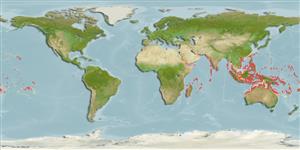>
Eupercaria/misc (Various families in series Eupercaria) >
Lethrinidae (Emperors or scavengers) > Lethrininae
Etymology: Lethrinus: Greek, lethrinia, a fish pertaining to genus Pagellus.
More on author: Forsskål.
Environment: milieu / climate zone / depth range / distribution range
Ekologi
laut berasosiasi dengan karang; nir-ruaya; kisaran kedalaman ? - 30 m (Ref. 2295). Tropical; 27°N - 26°S, 33°E - 138°W
Indo-Pacific: Red Sea and East Africa to the Ryukyu Islands and east to French Polynesia.
Length at first maturity / Size / Weight / umur
Maturity: Lm 23.7 range ? - 25.7 cm
Max length : 60.0 cm TL jantan/; (Ref. 30573); common length : 30.0 cm TL jantan/; (Ref. 30573); Umur maksimum dilaporkan: 14 Tahun (Ref. 2295)
Duri punggung (Keseluruhan (total)): 10; duri punggung lunak (Keseluruhan (total)): 9; Duri dubur 3; Sirip dubur lunak: 8. The body is light tan or olive to brown, becoming lighter below. the centers of the scales are often lighter than the background color. The head, often, has several broad indistinct vertical and diagonal light and dark bands. Sometimes there are white spots below the eye. The posterior edge of the operculum is dark brown. An orange-yellow stripe is on the lower part of the side with two additional more faint orange-yellow stripes above and one below this stripe. The fins are whitish or tan, sometimes mottled.
Found over seagrass beds (Ref. 41878), sand and rubble areas of lagoons and reefs (Ref. 30573). Found singly or in groups (Ref. 9710). Juveniles on weedy reefs (Ref. 48635). Feed on mollusks, crustaceans, and echinoderms (Ref. 30573). One of the commonest lethrinids along the coast of east Africa (Ref. 4369). Marketed fresh (Ref. 9775).
Gonochorism is inferred for this species as sizes of males and females overlapped and male gonad morphology is typical of secondarily derived testes (Ref. 103751). This may be supported further by the study of Ebisawa etal (2006) which characterised sexual pattern for this species as juvenile hermaphroditism indicating that sexual transition occurred before ovarian maturation, a case for non-functional hermaphroditism in Ref. 103751.
Carpenter, K.E. and G.R. Allen, 1989. FAO Species Catalogue. Vol. 9. Emperor fishes and large-eye breams of the world (family Lethrinidae). An annotated and illustrated catalogue of lethrinid species known to date. FAO Fish. Synop. 125(9):118 p. Rome: FAO. (Ref. 2295)
Status IUCN Red List (Ref. 130435)
ancaman kepada manusia
Harmless
penggunaan manusia
Perikanan: nilai komersial kecil
informasi lanjut
AcuanBudidaya airprofil budidaya airStrainGenetikaElectrophoresesDiturunkanPenyakit-penyakitPengolahanNutrientsMass conversion
Alat, peralatan
laporan khas
muat turun XML
Sumber internet
Estimates based on models
Preferred temperature (Ref.
123201): 26.1 - 29.3, mean 28.5 °C (based on 3253 cells).
Phylogenetic diversity index (Ref.
82804): PD
50 = 0.5000 [Uniqueness, from 0.5 = low to 2.0 = high].
Bayesian length-weight: a=0.01202 (0.00766 - 0.01887), b=2.97 (2.84 - 3.10), in cm total length, based on LWR estimates for this species & Genus-body shape (Ref.
93245).
Trophic level (Ref.
69278): 3.9 ±0.2 se; based on diet studies.
Generation time: 2.9 ( na - na) years. Estimated as median ln(3)/K based on 1
growth studies.
Daya lenting (Ref.
120179): Rendah, Waktu penggandaan populasi minimum 4.5 - 14 tahun (tmax=14).
Fishing Vulnerability (Ref.
59153): Low to moderate vulnerability (33 of 100).
Climate Vulnerability (Ref.
125649): Very high vulnerability (83 of 100).
Nutrients (Ref.
124155): Calcium = 41.4 [28.5, 59.9] mg/100g; Iron = 0.828 [0.549, 1.177] mg/100g; Protein = 20.4 [17.8, 22.6] %; Omega3 = 0.122 [0.087, 0.170] g/100g; Selenium = 39.8 [21.9, 64.1] μg/100g; VitaminA = 25.8 [5.6, 137.3] μg/100g; Zinc = 1.91 [1.44, 2.47] mg/100g (wet weight);
